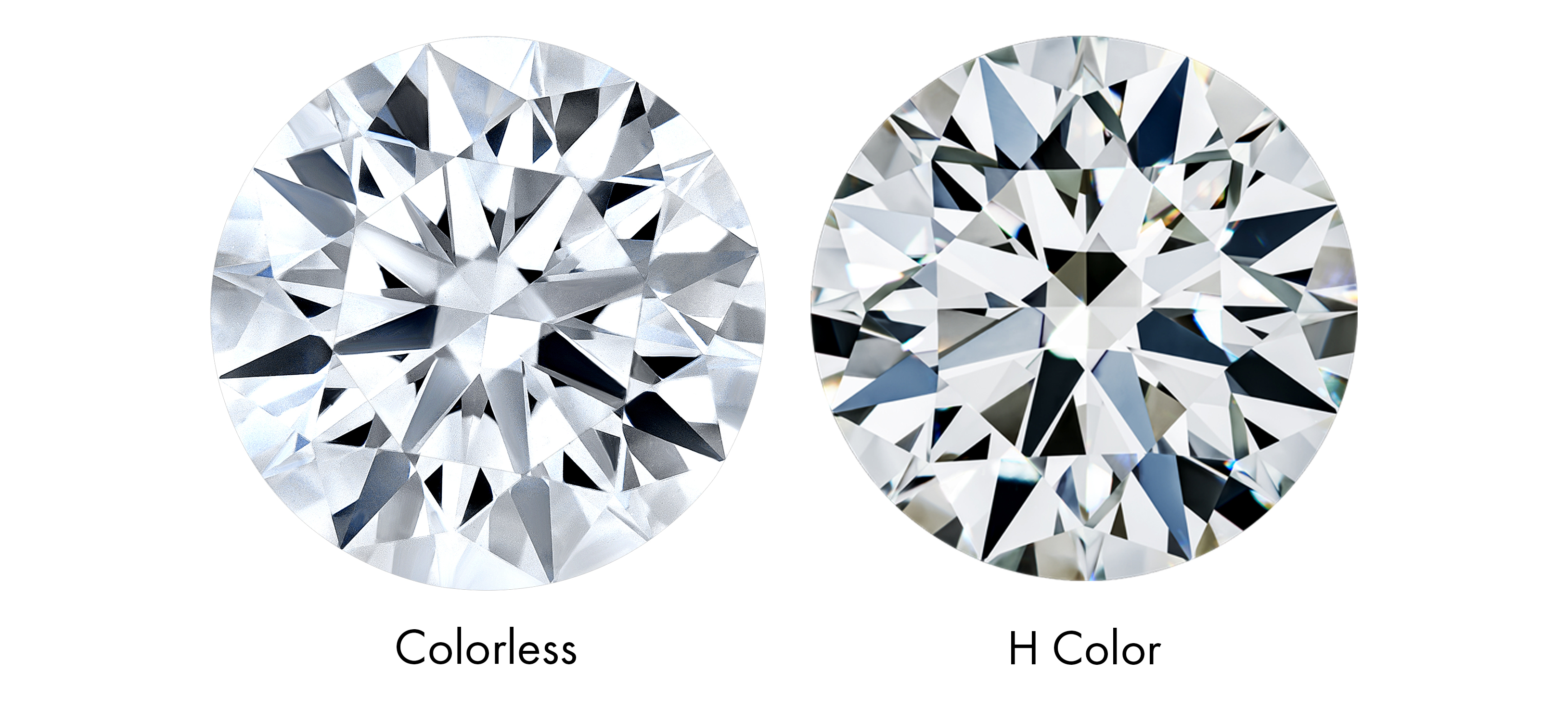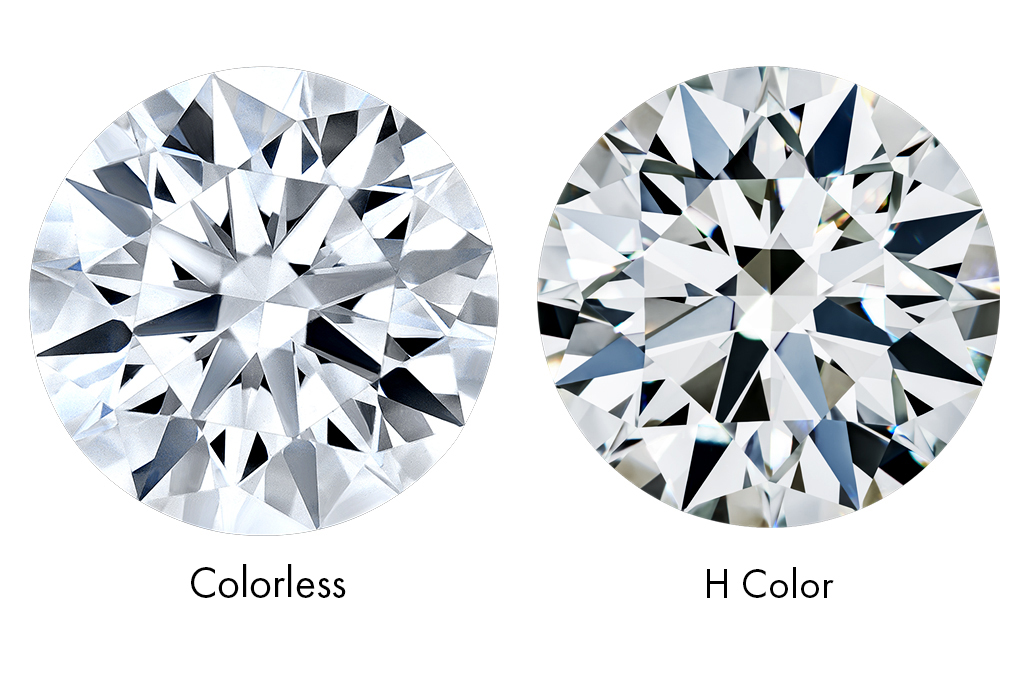

H Color Diamonds: Are They Right For You?
When you begin the process of buying an engagement ring, it’s easy to focus on your favorite diamond shapes and settings. But when it’s time to choose a diamond, there are new details to take into consideration — like the diamond 4Cs. The 4Cs — cut, color, clarity, and carat — refer to the unique attributes of each VRAI created diamond that undergo diamond grading to ensure the stone’s quality and value.
Like the other Cs, where your lab-grown diamond lands on the diamond color scale will directly impact its overall look and price tag. So understanding specific color grades is important. H color diamonds in particular are one of the most recommended diamond color grades— but are they right for you? Read on to discover why H color diamonds are a great place to start your search.
What Does ‘H Color Diamond’ Mean?
“H color diamond” refers to a specific color range of diamond on the diamond color scale. H color diamonds, along with G, I, and J color diamonds, are Near Colorless diamonds.
Near Colorless diamonds, when face up, still appear "colorless.” Most cannot tell the difference between the two categories without comparing them side by side against a white background.
The nuances between G, H, I, and J color diamonds are slight. But G and H diamonds are closer to “colorless” than I and J color diamonds are.
Is An H Color Diamond A Good Choice?
An H color diamond is a good choice for many engagement rings. Because it is so close to Colorless on the color scale, it will still shine bright in a platinum or white gold setting. Any small traces of color will be easily masked in a yellow or rose gold setting, as well.
The real benefit of an H color diamond is its price. Because it is lower on the scale than colorless or G color diamonds, you can expect to save significantly while still investing in high color quality. This is why this particular grade is so often recommended.
Ultimately, an H color diamond is a good choice if it fits within your budget and appeals to you personally.
How Do H Color Diamonds Compare?
The white diamond color scale ranges from D (colorless) to Z (which have a yellow-brown tint). Many jewelry brands, like VRAI, only sell Colorless, Near Colorless, and Faintly Colored diamonds (usually stopping at K color diamonds). So not only do H color diamonds sit at the center of the Near Colorless diamond spectrum, but also at the center of most jeweler’s inventory. This by no means makes them average, as H color diamonds are still incredibly valuable.
Read on to discover how H color diamonds compare to others on the diamond color scale.
G vs H Color Diamonds
The nuance between a G and H color diamond is indistinguishable to the untrained and naked eye. Gemologists can spot the faint tint or traces of color that would separate these two Near Colorless diamonds by comparing them side by side from the bottom up. But for most couples buying an engagement ring, it would be almost impossible to tell the difference.
The real difference between the two is price. An H color diamond with the same clarity, cut, and carat weight will cost less than a G. So if you’re between the two and need to stay within a budget, H is an excellent choice.
H vs I Color Diamonds
Like most color grades, telling the difference between H and I color diamonds would be extremely difficult to the untrained eye. I is lower on the color scale than H, but still considered Near Colorless. It is a particularly excellent choice for those purchasing a yellow or rose gold setting, as the color from the metal will mask any trace of color in the diamond.
Again, the true difference between the two is price. I color diamonds of the same clarity, cut, and carat weight will cost less than an H diamond.
H vs Colorless Diamonds
When compared side by side against a white background, you might be able to see that an H color diamond has a faint tint compared to Colorless D, E, and F diamonds. But in an engagement ring setting, particularly a yellow or rose gold setting, the difference is likely indistinguishable to most couples. But the difference in price can be dramatic. An H color diamond can cost anywhere between 10-15% less than Colorless diamonds, depending on the 4Cs.


H Color Diamonds And Clarity
Color and clarity are not determined by the same factors, meaning H color diamonds will land in different places on the diamond clarity chart. Some will be flawless, some very, very slightly included, and so on.
Determining if you should prioritize a higher or lower clarity grade for your H color diamond largely depends on your diamond shape. The large, open table of an Emerald cut diamond, for example, doesn’t hide inclusions as well as others, so prioritize clarity with this particular shape. As always, book an appointment with a diamond expert for more personalized advice.
H Color Diamonds And Cut
Not all H color diamonds have the same quality of cut. An Excellent or Very Good cut will keep most H color diamonds shining bright, while lower quality will affect their overall appearance.
Prioritizing cut once again depends on the diamond shape. A Round Brilliant H color diamond is best when its cut is Excellent or above (Ideal or Ideal + Hearts for VRAI created diamonds).
H Color Diamonds And Carat Weight
Obviously, not all H color diamonds weigh the same. Some H color diamonds might be featured as smaller side stones in a Three Stone engagement ring setting, while others might be much larger and on full display in a solitaire engagement ring.
The main implication carat will have on H color diamonds is price. Moving up in carat weight will steadily increase the price of your H color diamond, depending on the other Cs.
H Color Diamonds And Shape
Shape is one of the most important factors to consider when buying an H color diamond. The shape can have a direct impact on how this particular grade appears. An H color Round cut diamond will likely hide any small traces of color, for example.
Certain elongated shapes or diamonds with large facets might not hide color as well. For Asscher, Marquise, Pear, Oval, or Trillion diamonds, it’s a good idea to prioritize color and look for even distribution without pooling at the edges. So if you’re in between H and I for these particular shapes, consider going up in the color scale, depending on your setting.
H Color Diamonds And Metal Color
The biggest factor to consider before purchasing your H color diamond is the metal color of your setting. This, more than anything, will highlight or mask tints of color in your center stone. H color diamonds should work well with nearly any metal color, from platinum and white gold to yellow and rose gold.
Because platinum and white gold engagement rings tend to highlight traces of color, the near-colorless H works well in these settings depending on the particular diamond. If your budget allows, however, you can consider going higher or investing in a colorless diamond.
Because yellow gold engagement rings and rose gold engagement rings not only mask color, but can imbue a stone with their color, you can go even lower on the color scale with these settings if need be.
How Much Do H Color Diamonds Cost?
An H color diamond is by no means “inexpensive” as they are still incredibly valuable. But the cost difference between a colorless D diamond and an H can be staggering. So for individuals looking for the look of a Colorless diamond on a restricted budget, an H is a happy compromise.
Should You Buy An H Color Diamond?
If an H color diamond works best with your engagement ring setting and is in your budget, then yes, you should buy an H color diamond. At an approachable price point, you will enjoy its near-colorless quality and overall beauty for a lifetime.
Speak With Our Diamond Experts
Book a complimentary appointment with our diamond experts to determine if an H color diamond is right for you. They’ll give you personalized guidance, in-depth diamond education, and help finding engagement rings, wedding bands, fine jewelry gifts, and more.